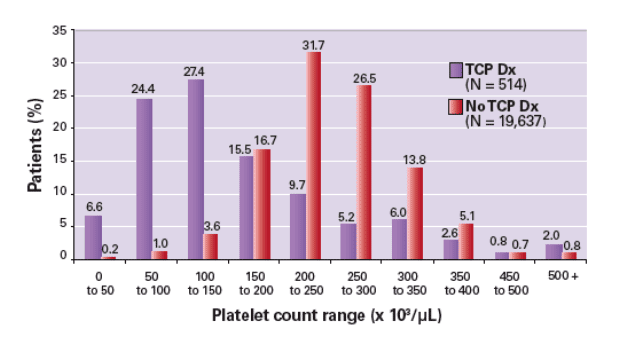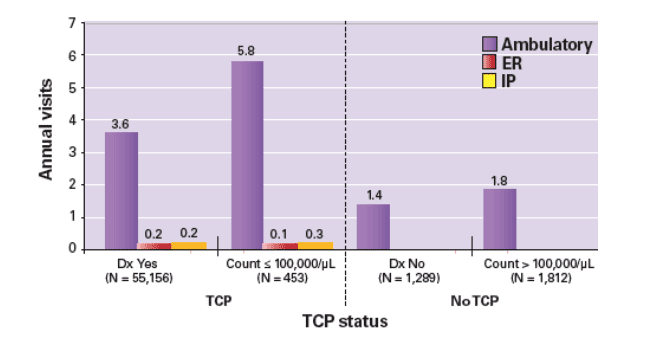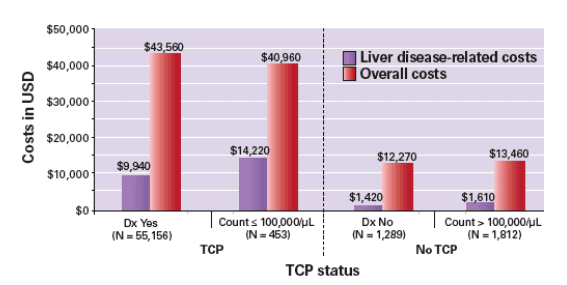| |
Medical Resource Utilization in Chronic Liver Disease Patients with Thrombocytopenia
|
| |
| |
Reported by Jules Levin
DDW, May 2007
F. Poordad1, M. Dalal2, K. Grotzinger2, S. Shetty3
1Cedars-Sinai Medical Center, Los Angeles, CA; 2GlaxoSmithKline, Collegeville, PA; 3I3 Innovus, Eden Prairie, MN
Author Conclusions:
CLD patients with TCP (thrombocytopenia) had significantly greater numbers of liver disease-related annual ambulatory, ER and inpatient visits.
Greater medical resource use in CLD patients with TCP directly translated into significantly greater annual liver disease-related costs and overall medical costs.
Medical care use and costs of patients with TCP were consistent regardless of whether TCP was defined by diagnosis or platelet count.
In lieu of histologic evidence of advanced liver disease, risk stratifying patients using platelet count can be a powerful tool.
Introduction
Chronic liver disease (CLD) includes many conditions with varying etiologies, existing on a continuum from hepatitis infection to cirrhosis.
Thrombocytopenia (TCP) is one of the most frequent hematological abnormalities in patients with CLD, especially in patients with cirrhosis and portal
hypertension.
Chronic liver diseases have been associated with increased risk of
thrombocytopenia due to:
-- Splenic pooling and destruction
-- Decreased thrombopoietin leading to decreased platelets.
Additionally, TCP can lead to:
-- Increased fatigue
-- Need for total or partial ablation of the spleen
-- Increases in bleeding or bruising events
-- Need for platelet transfusions.
In cirrhotic patients, low platelet count may inhibit and delay them from undergoing:
-- Surgery
-- Dental extractions
-- Liver biopsies
-- And preclude them from candidacy for liver transplantation.
Thus, maintaining appropriate platelet count/treatment for TCP in these populations represents an unmet medical need.
Objectives
-- Estimate prevalence of TCP among CLD patients.
-- Describe demographics and health care characteristics of CLD patients from real-world setting.
-- Determine risk of bleeding and use of platelet transfusion in CLD patients with TCP.
-- Estimate medical resource utilization and medical care costs associated with TCP in CLD.
Methods
Retrospective analysis of medical claims database.
-- Integrated US health plan with 23 million covered lives overall, with data available from 12.7 million covered lives over 3-year study period.
-- Includes pharmacy, medical, and laboratory administrative claims, and clinical laboratory results.
CLD patients were identified based on an index diagnosis of CLD between January 1, 2001 - December 31, 2003.
-- CLD determined by ICD9-CM diagnosis code 571.xx - 573.xx.
Identified TCP from ICD9-CM diagnosis codes 287.3 - 287.5.
Enrollment was continuous for at least 1 year prior to date of index diagnosis (baseline period) and 1 year after date of index diagnosis (follow-up period).
Sensitivity analysis was performed on a subset of patients (N = 20,151/56,445) for whom clinical laboratory data were available.
Analysis
Conducted analysis of medical resource utilization by comparing annual counts of ambulatory, emergency room (ER) visits and inpatient stays between those who had a TCP diagnosis and those who did not have TCP, using multivariate regression models.
Using regression models, compared annual liver diseaserelated medical care costs and overall costs in CLD patients with and without TCP diagnosis.
Controlled all multivariate (regression) analyses for baseline demographic attributes, health care characteristics, and baseline medical resource use.
Since TCP may not always have been diagnosed and/or reported in CLD patients, additional analyses on medical resource utilization and medical care costs were conducted in a subset of CLD patients with platelet test results.
-- CLD patients with platelet counts < 100,000/_L were considered to have TCP.
-- Each patient with platelet counts < 100,000/_L was matched on demographic and health care characteristics with four other patients with counts > 100,000/_L.
Results
Demographic and Health Characteristics of CLD Patients
Mean age of CLD patients was 48 years.
Half of CLD patients were women.
Annual prevalence of TCP among CLD patients ranged from 3.3% to 4.1%.
54% with TCP diagnosis had anemia vs 18% of those without TCP diagnosis.
21% with TCP diagnosis had neutropenia vs 2% of those without TCP diagnosis.
Liver transplants (2.1% vs 0.3%) and liver cancer (5.7% vs 1.5%) were greater among patients diagnosed with TCP.
Demographics:

Health Characteristics of CLD Patients With Platelet Test Results
Platelet result data were available in 36% of CLD patients (N = 20,151):
-- 2.6% (N = 514) had a platelet count > 100,000/_L
-- 28% with TCP diagnosis had bleeding events (N = 143) vs 10% of those without TCP diagnosis (N = 1,965)
-- 8% (N = 104) with TCP diagnosis had a platelet transfusion vs < 1% (N = 79) of those without TCP diagnosis.
Distribution of Index Platelet Count in CLD Patients
with Laboratory Data (N = 20,151) by TCP Diagnosis

TCP diagnosis found most often in patients with lower platelet counts; however, not all patients with low platelet counts have a TCP diagnosis.
Medical Resource Use
Analyses based on 56,445 patients with CLD.
< 2% of patients had any liver disease-related inpatient stay or ER visit during the follow-up period.
When compared with CLD patients without a TCP diagnosis, TCP patients:
-- Had 2 additional ambulatory visits (3.6 vs 1.4) per year
-- Were 13 times more likely to have a liver disease-related inpatient stay:
17 additional liver disease-related inpatient visits per 100 CLD patients per year
-- Were 4 times more likely to have an ER visit:
6 additional ER visits per 100 CLD patients per year.
Annual Counts of Ambulatory Visits, ER Visits and
Inpatient Stays in CLD Patients

TCP status was based on either a diagnosis of TCP (Dx Yes) or a platelet count < 100,000/_L.
There were significantly (p < 0.05) more visits and stays associated with TCP than without TCP, regardless of whether TCP was indicated by diagnosis or platelet count.
Medical Care Costs
When compared with CLD patients without a TCP diagnosis, patients with a TCP diagnosis had:
-- 3.5 times greater mean annual overall costs:
$43,560 vs $12,270 (p < 0.01) additional annual overall costs
-- 7 times greater mean annual liver disease-related costs:
$9,940 vs $1,420 (p < 0.01) additional annual liver disease-related costs.
Annual Liver Disease-related and Overall Medical
Resource Costs in CLD Patients

All costs were significantly (p < 0.05) greater in patients with TCP compared with those without TCP, regardless of whether TCP was indicated by diagnosis or platelet count.
Study Limitations
Study cohort comprised a heterogeneous patient population.
All patients with CLD may not have had a CLD diagnosis
(e.g., those whose CLD was due to hepatitis C).
TCP of most clinical concern for a sub-population of CLD patients; active intervention and management of TCP may be limited to this sub-population.
Occurrence and severity of bleeding events is somewhat subjective, thus bleeding events were not analyzed further.
Diagnosis and management of TCP is dependent on clinician's individual definition of TCP and a patient's disease and clinical situation.
|
|
| |
| |
|
|
|